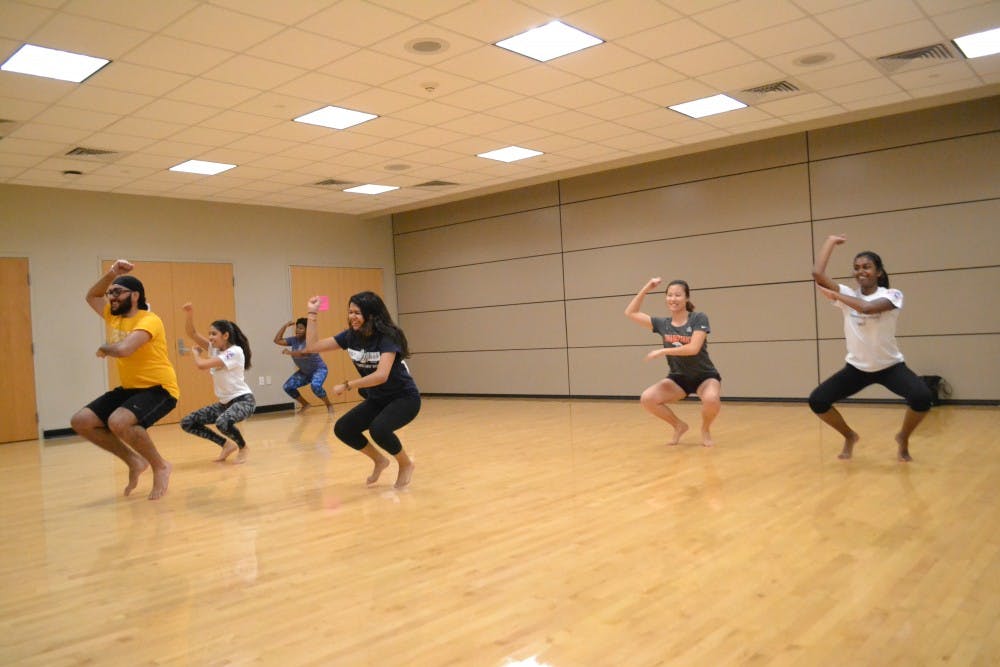On a Sunday morning in the Cassell Fitness Center studio, the American Bhangra Crew rehearses their routine for their upcoming performances this semester. The dancers follow the lead of co-choreographer Satinder Parmar, a freshman in the Kogod School of Business, as they studiously practice parts of the routine over and over. The American Bhangra Crew, or ABC as they sometimes call themselves, has 12 members this semester and works hard to perfect their dance for various gigs.
While AU has a comprehensive dance program with both a dance major and minor offered, student-run dance groups allow students to engage with their peers as well as various cultures and traditions through dance. However, being on a predominantly white campus can pose a bit of a challenge for groups that practice non-Western dance forms, such as Bhangra.
“I think a challenge might be getting people open to trying new things, especially with a different dance style on a campus where minorities aren’t as present. It’s kind of like being able to get people to step out of their comfort zone,” said Mckim Jean-Pierre, a senior and the president of ABC. Jean-Pierre learned about Bhangra by visiting the South Asian Student Association table at the annual involvement fair.
Bhangra is a dance form from Punjabi culture, which originates from the Punjab region in India and Pakistan. Bhangra is a very emotional dance form traditionally performed at weddings. Emotion is at the center of it, Parmar said, and sometimes the movements stem directly from song’s lyrics.
“It’s a fun way to connect community members,” Parmar said. “While Bhangra is very much a Punjabi thing, it’s very much so a South Asian thing, so people from India, Pakistan, Bangladesh, everywhere, they really love it and it really unifies South Asia in a way that takes out politics and religion.”
While ABC does not compete, they perform at multiple shows throughout the year, such as the SIS International Dinner and the No Lost Generation Gala. The group held auditions earlier in the semester. All potential members had to learn and film a routine, which then helped the four members of the Bhangra Crew executive board -- Parmar, Jean-Pierre, treasurer Sakshi Das and co-choreographer Kiran Ahluwalia -- select the members. Parmar said there is a mix of current dancers who have Bhangra experience with those who do not.
“A big part that I really like about most Bhangra teams at college campuses is that they’re diverse,” Parmar said. “We have a lot of people who maybe just heard of Bhangra and were like ‘that’s super cool, I saw it on YouTube, I’ll go to auditions.’”
Newer dance groups on campus share the same excitement to perform and build camaraderie, such as AU’s K-pop dance cover team. K-pop is short for Korean pop music, which is a specific music genre but also representative of a larger culture based around Korean pop music.
“It’s such a big culture, it’s not just about the music, even though the music is great, but it has this really unique style,” sophomore Brianna Bytner said. “It’s just so much fun to get in to, and the Korean language is beautiful, so all of that combined makes K-pop, and I feel like international fans get into it because it’s such a big phenomenon.”
Bytner established the dance team at the beginning of the spring 2018 semester. She wanted to develop a specific dance group out of a K-pop general interest club. The team currently has 10 members and is focusing on learning different K-pop covers to film.
“My hopes for the future are that once we have a mix of songs put together, we’re going to film it, and then I also want to reach out to other clubs on campus and hopefully put on an exhibition or some kind of show where we can show people Korean culture and we can also perform that, and see if we can also perform at other events as well,” Bytner said of her plans for the future of the team.
Similar to the American Bhangra Crew, it’s tricky for the K-pop dance cover team to attract new members because many students on AU’s campus are unfamiliar with the dance form.
“It was hard to find other people who enjoyed K-pop,” Bytner said. “And so I wanted to make a club, but I also wanted to have a dance cover team where we could perform K-pop covers because I also have a big passion for dancing.”
Elizabeth Anderson, a freshman in SIS on the team, said that before she joined she had never danced before. When she watched the popular K-pop group, BTS, perform at the 2017 American Music Awards in November, she thought it was interesting and decided to teach herself the dance they performed.
“I thought to myself, ‘I’m gonna figure it out and learn how to do it, that’s my goal,’ and I figured it out, and then it spiraled, and here I am,” Anderson said.
Almost every member of the team has K-pop experience, although Bytner said the few people without experience who came to auditions were hooked. She said she hopes more students will hear about K-pop and want to try it out.
“I learned so much through that and I feel like that’s what people can also take from this group eventually, is they’ll know more about K-pop and then hopefully every group on campus will just get more involved and well-known,” Bytner said.
Britta Peterson, the head of the AU Dance Program, echoed the desire for more dance groups on campus, as they contribute to a stronger dance presence at AU. Peterson is in her second year in the position and has overseen recent change in the dance program, such as the addition of a dance major.
With 13 declared majors currently in the program, “there’s clearly an interest in dance on campus,” Peterson said. “Eagles want to dance.”
“Something that dance clubs help with is that people don’t usually know that the dance program exists,” Peterson said. “People don’t know that we’re here, and that’s a big problem that I’m still trying to solve.”
Peterson said that an understanding of world dance forms and art forms from other cultures are crucial to developing an understanding of different countries and regions of the world, and when the arts at AU are physically separated from the rest of the main campus in the Katzen Arts Center, this can hurt the visibility and value of art.
“I am really committed to an inclusionary, non-Western dance culture, but if the students do not come, it cannot work,” she said. “You think that you’re gonna be a good diplomat without understanding the different artistic and cultural experiences of these places that you want to be engaging with? … When you’re engaging with these dance forms you are literally embodying the cultural knowledge that comes with that dance form, which is so powerful.”
This story was originally published in the April print edition of The Eagle.





